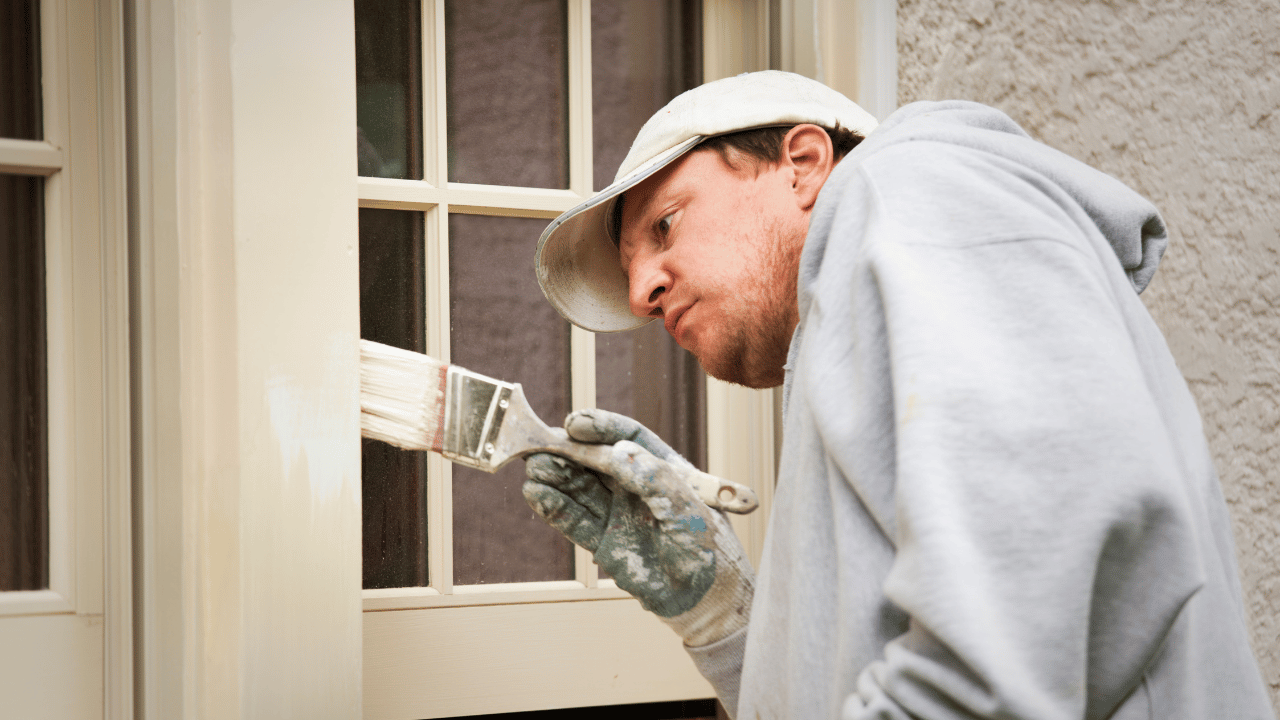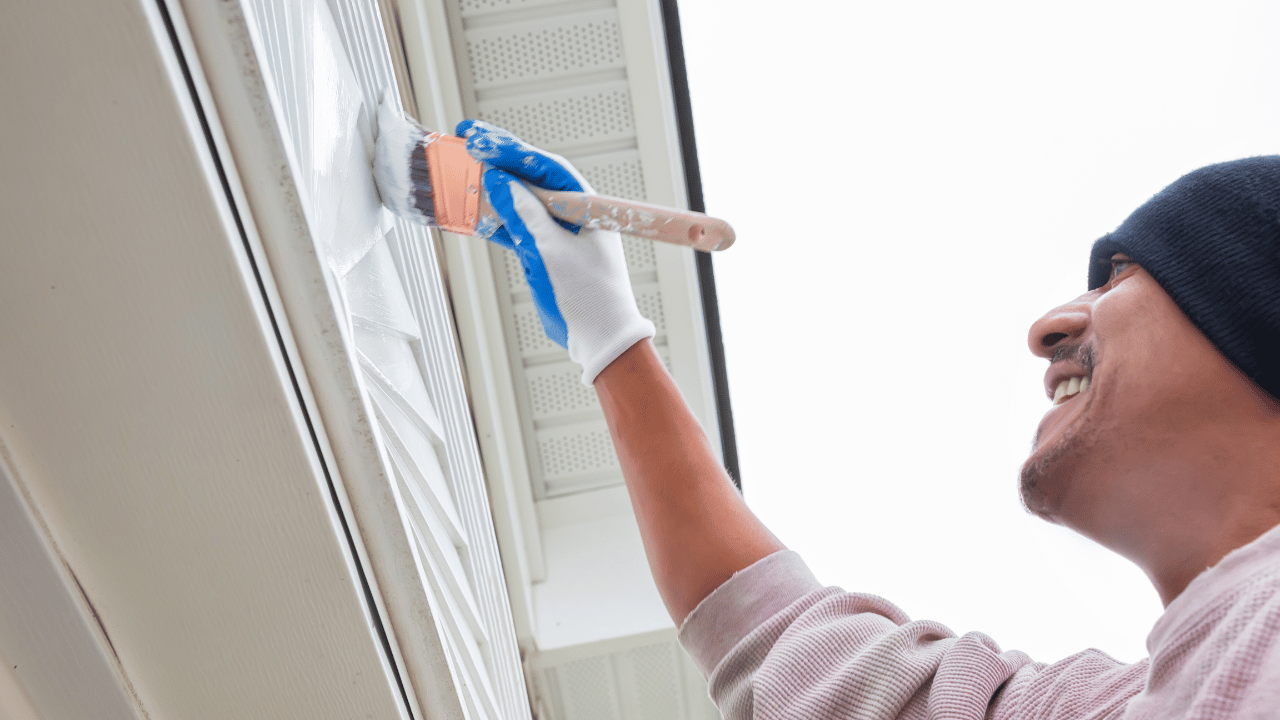Last Updated on September 7, 2023 by Pro Handyman Australia – Editorial Team
The Importance of Paint Selection
Painting your home’s exterior isn’t just about aesthetics; it’s about safeguarding its exterior and ensuring longevity. While the temptation might be to dive right in, making the right paint choice beforehand can be the difference between a paint job that stands the test of time and one that fades or peels prematurely. With the exterior paint playing such a pivotal role in a home’s curb appeal and protection, it’s crucial to be informed about the best type for your specific needs.
Acrylic Paints: Durability Meets Elasticity
Acrylic paints are renowned for their high-quality ingredients, which give them a thick and rich consistency. Their chemical composition enhances elasticity, allowing them to expand and contract with temperature fluctuations. This flexibility makes acrylic paints especially suitable for exterior use.
Not only are acrylic paints durable, but they’re also versatile. Whether your siding is made of wood, aluminum, or fiber cement, acrylic paints are a commendable choice. They seamlessly cover surfaces like stucco, plaster, and drywall, adding vibrancy and protection.
Latex Paints: Cost-Effective and Easy Application
If you’re in search of an affordable paint that doesn’t compromise on quality, latex paints might be your best bet. Their water-based nature means they are simple to apply and clean, and they dry relatively quickly. Just like their acrylic counterparts, latex paints can adjust to varying temperatures.
However, it’s essential to ensure that you select a latex paint intended for exterior use, as there are both indoor and outdoor varieties available.
Oil-Based Paints: Smooth Finish with Caution
While not as prevalent today due to health concerns, oil-based paints have their unique set of advantages. They emit potent fumes when wet, so it’s essential to ensure proper ventilation and wear a protective mask if you’re painting without professional help.
Oil-based paints offer some distinct benefits for certain exterior applications. They tend to shrink less than their acrylic and latex counterparts, ensuring a smoother finish. They excel in high-traffic areas and apply seamlessly, making them ideal for specific surfaces like porch floors, doors, trims, and detailed work.
However, there are a few drawbacks to consider. Oil-based paints tend to be more susceptible to cracking and fading over time compared to latex and acrylic options. Additionally, their oil composition makes cleaning a more challenging task.
Understanding Paint Finishes for Exterior Projects
Choosing the Right Finish

The exterior paint’s finish plays a crucial role in its final appearance and functionality. It’s determined by the ratio of resins and binders to pigment levels. The right finish depends on your specific project needs, from painting detailed trims to vast siding expanses. Consider both the surface’s function and your desired aesthetic outcome to make the best choice.
Flat or Matte Finish: Elegance and Concealment
Flat or matte paint delivers a solid, non-reflective finish, making it perfect for painting older houses. Its ability to mask imperfections can breathe new life into aging surfaces, providing them with a refreshed, modern feel. However, its porous nature makes it less durable. Therefore, while it’s ideal for exterior siding, it might not be the best choice for high-traffic areas such as doors and windows.
Satin Finish: The Perfect Balance
Often dubbed eggshell or low-luster, satin paint strikes the perfect balance between shine and matte. Its versatile sheen complements most surfaces, with wood or cement siding standing out exceptionally. But ensure your satin paint is thoroughly mixed before use. To achieve a consistent sheen, consider having the store mix it for you.
Semi-Gloss and Glossy Finish: Resilience with a Shine
Glossy paints are the go-to for those seeking durability combined with a lustrous shine. They’re particularly suitable for trims exposed to weather elements, such as window sills and garage doors. Their resistance to scuff marks and general durability makes them apt for surfaces with heavy wear.
Semi-gloss paints, on the other hand, offer a slightly muted shine. Their stain resistance and durability make them suitable for doors and trims. Opt for semi-gloss finishes in places where you desire long-lasting resilience against the elements. However, avoid high gloss finishes on surfaces with noticeable dents or imperfections, as they can draw attention to these flaws.
Tailoring Paint Choices by Material

Wood and Decks: Guarding Against Elements
Exterior wood surfaces, be it decks or wood siding, demand paints that safeguard against moisture and water damage. Opt for paints that promise fade resistance, ensuring protection against ultraviolet rays. Acrylic-based paints come highly recommended for their added protection against cracking, peeling, and blistering.
Porches and Patios: Withstanding Traffic and Weather
Given their exposure to foot traffic and varying weather conditions, porches and patios require robust paints. Choose formulations designed to brave the elements. These paints are suitable for exterior wood, concrete, breezeways, and even basement floors. Their enamel finish also assures resistance to wear and scratches.
Brick and Stucco: Binding and Protecting
For brick or stucco surfaces, masonry paint is your best ally. This paint offers a flat finish that conceals surface blemishes effectively. It bonds securely to the surface and incorporates chalk-block technology, ensuring protection against potential issues like cracking, peeling, and efflorescence. This phenomenon, a chalky white residue, can occasionally form on masonry, making the right paint choice even more vital.
Selecting the Right Paint Finish for Your Exterior
Understanding Sheen and Durability
When embarking on an exterior painting project, the paint finish or sheen is pivotal. The sheen essentially quantifies the paint’s light reflection ability. Typically, the shinier the paint, the more resistant it is to staining. Although various manufacturers might have different names for them, sheens are commonly categorized into the following:
Gloss and High-Gloss: Resilience with Radiance
Glossy finishes, including the high-gloss variants, rank among the top choices for exterior house paints, primarily due to their resilience and ease of cleaning. Their impressive resistance to scuffs makes them ideal for areas that frequently come in contact, such as doors, door frames, and window casings. Moreover, they can enhance the appeal of shutters and trims, creating a striking contrast to the siding. However, a word of caution: if your exterior surfaces have imperfections, the highly reflective nature of gloss and high-gloss finishes will accentuate them.
Semi-Gloss: A Balance of Shine and Durability
A notch below in sheen compared to the glossy variants, semi-gloss paints still retain considerable durability and ease of cleaning. Their slight reduction in shine does not compromise their stain resistance, making them apt for doors, trims, and casings. If you’re looking for a paint type that combines longevity with a modest shine, especially for areas constantly exposed to weathering, semi-gloss is your go-to choice.
Satin: Versatility with a Gentle Sheen
Frequently known as low-luster, satin paints strike a balance between durability and a subdued shine. They are versatile, making them suitable for wood or cement sidings that are in good shape. Considering a fresh coat for your exterior brick? Satin paint’s easy-to-clean property—often requiring just a hose-down—makes it a prime candidate.
Flat and Matte: Concealing with Subtlety
For surfaces with imperfections, flat or matte finishes come to the rescue. Their minimalistic luster helps camouflage minor dents and scratches, giving surfaces a smooth appearance. An added advantage of flat paint is its reduced propensity to splatter during application, coupled with the ease of touch-ups when needed.
Key Qualities to Look for in Exterior House Paint

Understanding Hiding Power
The hiding power of paint pertains to its ability to effectively cover or mask the surface where it’s applied. This property stems from the paint’s pigment and can be influenced by how it’s applied and its thickness. Ideally, a paint with strong hiding power should be capable of masking imperfections and previous paint layers.
The Significance of Color Retention
When discussing tinted paint, color retention is a vital characteristic. It’s the paint’s ability to hold onto its original hue, even when exposed to various external elements.
Combatting Chalking: The Role of Resistance
Chalking resistance ensures that your paint doesn’t develop a white, chalky powder on its surface, which can subsequently cause the paint color to appear lighter. Over time, as the binder deteriorates, chalking can manifest. If you’ve ever noticed streaks on painted surfaces, this could be due to the absence of chalking resistance. To avoid this, seek out paint rich in quality resins.
Understanding Blister Resistance
For a paint job that remains intact, blister resistance is essential. This quality ensures that the paint layer remains unaffected by excessive moisture seeping through the underlying surface. Always remember to apply paint on a thoroughly dry surface; otherwise, blistering issues might arise.
The Vital Role of Primer in Painting Exteriors
The application of a primer is a crucial step in exterior painting. It not only facilitates better adhesion of paint but also ensures a uniform look and enhances durability. If you’re attempting to cover vivid or deep hues, priming becomes indispensable. For especially challenging color transitions, opt for primers that offer high hiding capabilities.
You might be pondering the distinctions between interior and exterior paint primers. In essence, exterior primers are crafted to be more robust, offering protection against issues like mildew, cracking, and erosion. Depending on the surface, the choice of primer varies:
- Oil-Based Primers: These excel in covering stains and are suitable for both painted or unpainted wood and metals, especially those susceptible to rust. They effectively seal surfaces, promoting even paint application. However, they tend to become brittle over time.
- Water-Based Latex Primers: Drying faster than their oil-based counterparts and boasting greater flexibility, latex primers are particularly beneficial for wood surfaces which can experience expansion and contraction. It’s crucial to pair latex primers exclusively with water-based paints. These primers also fare well with concrete.
Regardless of your primer choice, ensure the surface is immaculately clean and prepped. After priming, allow sufficient drying time before you commence painting. In regions with high humidity, the primer might need upwards of three hours to dry completely.
Evaluating the Quality of Paint
When searching for the perfect paint for your home, it’s not always about the price tag. The key is to understand and assess the paint’s characteristics, as discussed throughout this article.
Thorough research is essential. Delve into comparison reviews of specific brands and products. If in doubt, a product’s warranty can serve as a testament to its quality. It provides insight into the expected performance and durability of the paint, giving you an idea of its overall value.
Contrary to the popular belief that ‘all paints are the same,’ there’s a significant difference in quality across brands and types. While you often get what you pay for, determining the real value lies in understanding the potential return on your investment (ROI). Think of paint not just as a means to refresh your space, but as an investment that safeguards and enhances your home’s beauty.
More premium paints tend to offer added advantages over their budget-friendly counterparts. However, these additional features may not always align with your personal requirements. Furthermore, there comes a point where the incremental benefits might not justify the higher costs. Hence, the best approach is to establish a feasible budget and seek the finest paint that aligns with that range.
Conclusion
In the realm of paints, it’s crucial to strike a balance between quality and cost. While it’s tempting to gravitate towards the most expensive option, it’s essential to assess its tangible benefits for your specific project. Set a budget, do your research, and ensure you’re making a well-informed decision that promises both durability and aesthetic appeal.
